

Compact Muon Solenoid
LHC, CERN
| CMS-EXO-20-003 ; CERN-EP-2021-198 | ||
| Search for long-lived particles produced in association with a Z boson in proton-proton collisions at $\sqrt{s} = $ 13 TeV | ||
| CMS Collaboration | ||
| 25 October 2021 | ||
| JHEP 03 (2022) 160 | ||
| Abstract: A search for long-lived particles (LLPs) produced in association with a Z boson is presented. The study is performed using data from proton-proton collisions with a center-of-mass energy of 13 TeV recorded by the CMS experiment during 2016-2018, corresponding to an integrated luminosity of 117 fb$^{-1}$. The LLPs are assumed to decay to a pair of standard model quarks that are identified as displaced jets within the CMS tracker system. Triggers and selections based on Z boson decays to electron or muon pairs improve the sensitivity to light LLPs (down to 15 GeV{}). This search provides sensitivity to beyond the standard model scenarios which predict LLPs produced in association with a Z boson. In particular, the results are interpreted in the context of exotic decays of the Higgs boson to a pair of scalar LLPs (H $\to$ SS). The Higgs boson decay branching fraction is constrained to values less than 6% for proper decay lengths of 10-100 mm and for LLP masses between 40 and 55 GeV. In the case of low-mass ($\approx$15 GeV) scalar particles that subsequently decay to a pair of b quarks, the search is sensitive to branching fractions ${\mathcal{B}} (\mathrm{H \to SS}) < $ 20% for proper decay lengths of 10-50 mm. The use of associated production with a Z boson increases the sensitivity to low-mass LLPs of this analysis with respect to gluon fusion searches. In the case of 15 GeV scalar LLPs, the improvement corresponds to a factor of 2 at a proper decay length of 30 mm. | ||
| Links: e-print arXiv:2110.13218 [hep-ex] (PDF) ; CDS record ; inSPIRE record ; HepData record ; Physics Briefing ; CADI line (restricted) ; | ||
| Figures | |
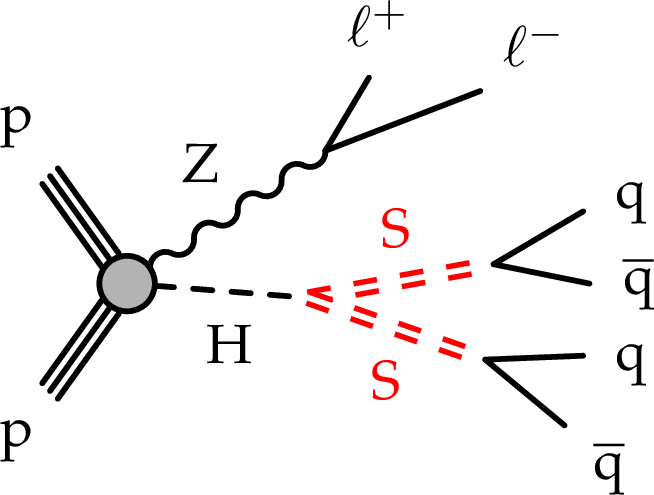
png pdf |
Figure 1:
Feynman diagram of a simplified model for the Higgs boson decaying to a pair of long-lived scalar particles (S). The Higgs boson is produced in association with a Z boson, where the Z boson decays to a pair of leptons. The long-lived scalars decay to a pair of quark jets (q). |
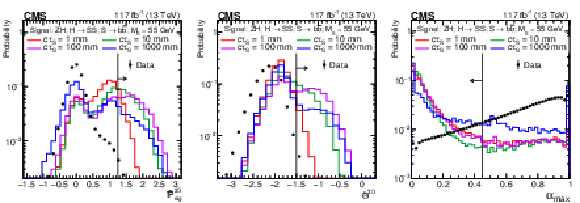
png pdf |
Figure 2:
Distributions of the three tagging variables for data and for four signal samples, where the decay lengths of the signal range from 1 to 1000 mm. The left figure displays the distributions for the ${\hat{\mathrm {IP}}^\mathrm {2D}_\text {sig}}$ tagging variable, while the center and right figures display the distributions for the ${\hat{\Theta}^\mathrm {2D}}$ and ${\alpha _\text {max}}$ tagging variables, respectively. Overlaid on the figures is a line with an arrow pointing to the region of where values of the variable are used to aid in distinguishing possible displaced jets from background jets. |

png pdf |
Figure 2-a:
The figure displays the distributions for the ${\hat{\mathrm {IP}}^\mathrm {2D}_\text {sig}}$ tagging variable for data and for four signal samples, where the decay lengths of the signal range from 1 to 1000 mm. Overlaid on the figure is a line with an arrow pointing to the region of where values of the variable are used to aid in distinguishing possible displaced jets from background jets. |
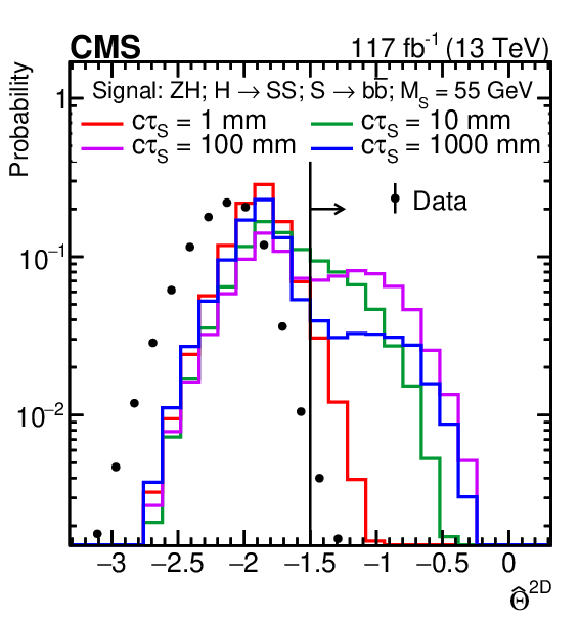
png pdf |
Figure 2-b:
The figure displays the distributions for the ${\hat{\Theta}^\mathrm {2D}}$ tagging variable for data and for four signal samples, where the decay lengths of the signal range from 1 to 1000 mm. Overlaid on the figure is a line with an arrow pointing to the region of where values of the variable are used to aid in distinguishing possible displaced jets from background jets. |

png pdf |
Figure 2-c:
The figure displays the distributions for the ${\alpha _\text {max}}$ tagging variable for data and for four signal samples, where the decay lengths of the signal range from 1 to 1000 mm. Overlaid on the figure is a line with an arrow pointing to the region of where values of the variable are used to aid in distinguishing possible displaced jets from background jets. |
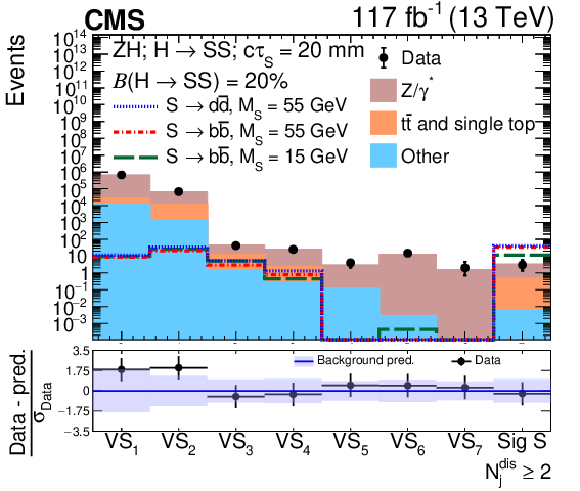
png pdf |
Figure 3:
The background estimate and the observed data in the $ {N_{\mathrm {j}}^{\text {dis}}} \geq $ 2 bin, for each of the seven validation samples (VS$_{1}$ through VS$_{7}$), along with the signal sample (Sig S). Signal model distributions for scalar masses of 15 and 55 GeV with a proper mean decay length of 20 mm are also shown. The Higgs boson branching fraction to long-lived scalars (${\mathcal{B}} (\mathrm{H \to SS})$) is set to 20%. |

png pdf |
Figure 4:
Exclusion limits at 95% CL on the Higgs boson branching fraction to long-lived scalars ${\mathcal{B}} (\mathrm{H \to SS})$. Limits are presented for scalar decays to d quarks (left) and b quarks (right) as a function of the mean proper decay length of the scalar. The limits for the different scalar masses are shown in different colors for each scalar decay mode. |
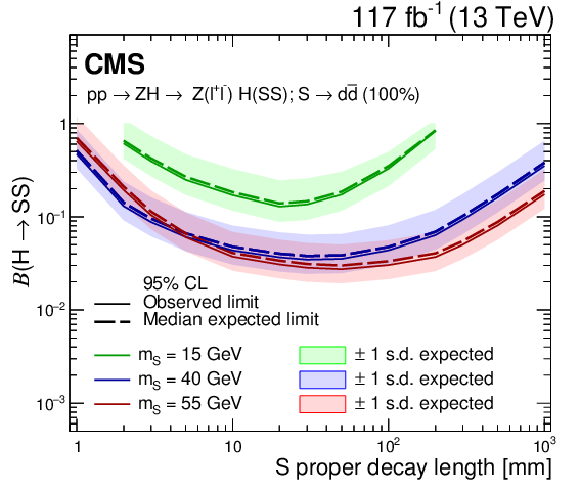
png pdf |
Figure 4-a:
Exclusion limits at 95% CL on the Higgs boson branching fraction to long-lived scalars ${\mathcal{B}} (\mathrm{H \to SS})$. Limits are presented for scalar decays to d quarks as a function of the mean proper decay length of the scalar. The limits for the different scalar masses are shown in different colors for each scalar decay mode. |

png pdf |
Figure 4-b:
Exclusion limits at 95% CL on the Higgs boson branching fraction to long-lived scalars ${\mathcal{B}} (\mathrm{H \to SS})$. Limits are presented for scalar decays to b quarks as a function of the mean proper decay length of the scalar. The limits for the different scalar masses are shown in different colors for each scalar decay mode. |
| Tables | |

png pdf |
Table 1:
The systematic uncertainties in the background and signal yield expectations. Dashes indicate that the systematic effect is not applicable or is negligible. |
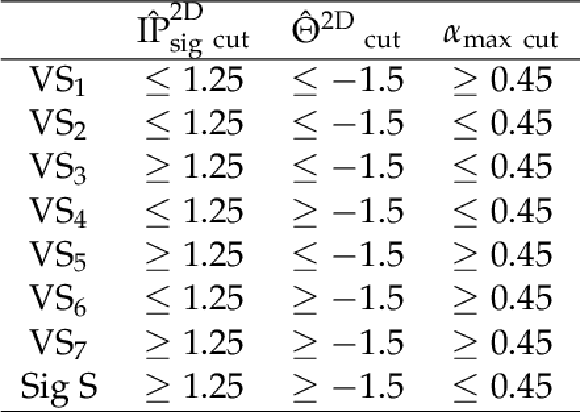
png pdf |
Table 2:
Summary of the track-based displaced-jet tagging requirements to define the seven validation samples, VS$_{1}$ through VS$_{7}$, and the signal sample Sig S. |

png pdf |
Table 3:
Observed data and estimated background yields in the search sample for the three ${N_{\mathrm {j}}^{\text {dis}}}$ bins. The estimated background yields are obtained using the fit procedure described in Sec. 5. Signal yields for two model points are also shown, where the Higgs boson decay branching fraction ${\mathcal{B}} (\mathrm{H \to SS})$ is assumed to be 10%. |
| Summary |
| A search for long-lived particles (LLPs) produced in association with a Z boson decaying to a pair of electrons or muons has been performed. The decays of LLPs in the tracker volume result in a displaced-jet signature, which is used to distinguish signal from SM background. No excess over the expected SM event rate is observed. The results of this search provide sensitivity to beyond the SM scenarios that predict LLPs produced in association with a Z boson. In particular, stringent exclusion limits on exotic Higgs boson decays to long-lived scalars are obtained. The Higgs boson decay branching fraction ${\mathcal{B}} (\mathrm{H \to SS})$ is constrained to values less than 6% for proper decay lengths of 10-100 mm and for long-lived particle masses between 40 and 55 GeV. In the case of low-mass ($\approx$15 GeV) scalar particles that subsequently decay to a pair of b quarks, the search is sensitive to branching fractions ${\mathcal{B}} (\mathrm{H \to SS}) < $ 20% for mean proper decay lengths of 10-50 mm. This corresponds to an improvement in sensitivity with respect to gluon fusion searches by a factor of 2 at a proper decay length of 30 mm. |
| References | ||||
| 1 | A. Arvanitaki, N. Craig, S. Dimopoulos, and G. Villadoro | Mini-split | JHEP 02 (2013) 126 | 1210.0555 |
| 2 | N. Arkani-Hamed et al. | Simply unnatural supersymmetry | 1212.6971 | |
| 3 | G. F. Giudice and R. Rattazzi | Theories with gauge mediated supersymmetry breaking | PR 322 (1999) 419 | hep-ph/9801271 |
| 4 | R. Barbier et al. | $ R $-parity violating supersymmetry | PR 420 (2005) 1 | hep-ph/0406039 |
| 5 | C. Csaki, E. Kuflik, and T. Volansky | Dynamical $ R $-parity violation | PRL 112 (2014) 131801 | 1309.5957 |
| 6 | J. Fan, M. Reece, and J. T. Ruderman | Stealth supersymmetry | JHEP 11 (2011) 012 | 1105.5135 |
| 7 | J. Fan, M. Reece, and J. T. Ruderman | A stealth supersymmetry sampler | JHEP 07 (2012) 196 | 1201.4875 |
| 8 | G. Burdman, Z. Chacko, H.-S. Goh, and R. Harnik | Folded supersymmetry and the LEP paradox | JHEP 02 (2007) 009 | hep-ph/0609152 |
| 9 | H. Cai, H.-C. Cheng, and J. Terning | A quirky little Higgs model | JHEP 05 (2009) 045 | 0812.0843 |
| 10 | Z. Chacko, H.-S. Goh, and R. Harnik | The twin Higgs: natural electroweak breaking from mirror symmetry | PRL 96 (2006) 231802 | hep-ph/0506256 |
| 11 | M. J. Strassler and K. M. Zurek | Echoes of a hidden valley at hadron colliders | PLB 651 (2007) 374 | hep-ph/0604261 |
| 12 | M. J. Strassler and K. M. Zurek | Discovering the Higgs through highly-displaced vertices | PLB 661 (2008) 263 | hep-ph/0605193 |
| 13 | M. Baumgart et al. | Non-Abelian dark sectors and their collider signatures | JHEP 04 (2009) 014 | 0901.0283 |
| 14 | D. E. Kaplan, M. A. Luty, and K. M. Zurek | Asymmetric dark matter | PRD 79 (2009) 115016 | 0901.4117 |
| 15 | K. R. Dienes and B. Thomas | Dynamical dark matter: I. Theoretical overview | PRD 85 (2012) 083523 | 1106.4546 |
| 16 | K. R. Dienes, S. Su, and B. Thomas | Distinguishing dynamical dark matter at the LHC | PRD 86 (2012) 054008 | 1204.4183 |
| 17 | Y. Cui and B. Shuve | Probing baryogenesis with displaced vertices at the LHC | JHEP 02 (2015) 049 | 1409.6729 |
| 18 | B. Batell, M. Pospelov, and B. Shuve | Shedding light on neutrino masses with dark forces | JHEP 08 (2016) 052 | 1604.06099 |
| 19 | Z. Chacko, D. Curtin, and C. B. Verhaaren | A quirky probe of neutral naturalness | PRD 94 (2016) 011504 | 1512.05782 |
| 20 | D. Curtin et al. | Exotic decays of the 125 GeV Higgs boson | PRD 90 (2014) 075004 | 1312.4992 |
| 21 | CMS Collaboration | Search for long-lived particles using displaced jets in proton-proton collisions at $ \sqrt{s} = $ 13 TeV | PRD 104 (2021) 012015 | CMS-EXO-19-021 2012.01581 |
| 22 | CMS Collaboration | Search for long-lived particles decaying in the CMS end cap muon detectors in proton-proton collisions at $ \sqrt{s} = $ 13 TeV | PRL 127 (2021) 261804 | CMS-EXO-20-015 2107.04838 |
| 23 | ATLAS Collaboration | Search for long-lived particles produced in pp collisions at $ \sqrt{s} = $ 13 TeV that decay into displaced hadronic jets in the ATLAS muon spectrometer | PRD 99 (2019) 052005 | 1811.07370 |
| 24 | ATLAS Collaboration | Search for long-lived neutral particles in pp collisions at $ \sqrt{s} = $ 13 TeV that decay into displaced hadronic jets in the ATLAS calorimeter | EPJC 79 (2019) 481 | 1902.03094 |
| 25 | ATLAS Collaboration | Search for long-lived neutral particles produced in pp collisions at $ \sqrt{s} = $ 13 TeV decaying into displaced hadronic jets in the ATLAS inner detector and muon spectrometer | PRD 101 (2020) 052013 | 1911.12575 |
| 26 | ATLAS Collaboration | Search for exotic decays of the higgs boson into long-lived particles in pp collisions at $ \sqrt{s} = $ 13 TeV using displaced vertices in the ATLAS inner detector | Submitted to JHEP | 2107.06092 |
| 27 | CMS Collaboration | HEPData record for this analysis | link | |
| 28 | CMS Collaboration | Description and performance of track and primary-vertex reconstruction with the CMS tracker | JINST 9 (2014) P10009 | CMS-TRK-11-001 1405.6569 |
| 29 | CMS Collaboration | The CMS trigger system | JINST 12 (2017) P01020 | CMS-TRG-12-001 1609.02366 |
| 30 | CMS Collaboration | Performance of the CMS Level-1 trigger in proton-proton collisions at $ \sqrt{s} = $ 13 TeV | JINST 15 (2020) P10017 | CMS-TRG-17-001 2006.10165 |
| 31 | CMS Collaboration | The CMS experiment at the CERN LHC | JINST 3 (2008) S08004 | CMS-00-001 |
| 32 | CMS Collaboration | Performance of the CMS muon trigger system in proton-proton collisions at $ \sqrt{s} = $ 13 TeV | JINST 16 (2021) P07001 | CMS-MUO-19-001 2102.04790 |
| 33 | P. Nason | A new method for combining NLO QCD with shower Monte Carlo algorithms | JHEP 11 (2004) 040 | hep-ph/0409146 |
| 34 | S. Frixione, P. Nason, and C. Oleari | Matching NLO QCD computations with parton shower simulations: the POWHEG method | JHEP 11 (2007) 070 | 0709.2092 |
| 35 | S. Alioli, P. Nason, C. Oleari, and E. Re | A general framework for implementing NLO calculations in shower Monte Carlo programs: the POWHEG BOX | JHEP 06 (2010) 043 | 1002.2581 |
| 36 | S. Alioli, P. Nason, C. Oleari, and E. Re | NLO single-top production matched with shower in POWHEG: $ s $- and $ t $-channel contributions | JHEP 09 (2009) 111 | 0907.4076 |
| 37 | E. Re | Single-top $ \mathrm{W}\mathrm{t} $-channel production matched with parton showers using the POWHEG method | EPJC 71 (2011) 1547 | 1009.2450 |
| 38 | G. Luisoni, P. Nason, C. Oleari, and F. Tramontano | $ \mathrm{H}\mathrm{W}^\pm $/$ \mathrm{H}\mathrm{Z} $ + 0 and 1 jet at NLO with the POWHEG BOX interfaced to GoSam and their merging within MiNLO | JHEP 10 (2013) 083 | 1306.2542 |
| 39 | D. de Florian et al. | Handbook of LHC Higgs cross sections: 4. Deciphering the nature of the Higgs sector | CERN-2017-002-M | 1610.07922 |
| 40 | T. Sjostrand et al. | An introduction to PYTHIA 8.2 | CPC 191 (2015) 159 | 1410.3012 |
| 41 | J. Alwall et al. | The automated computation of tree-level and next-to-leading order differential cross sections, and their matching to parton shower simulations | JHEP 07 (2014) 079 | 1405.0301 |
| 42 | Y. Li and F. Petriello | Combining QCD and electroweak corrections to dilepton production in FEWZ | PRD 86 (2012) 094034 | 1208.5967 |
| 43 | M. Czakon and A. Mitov | Top++: A program for the calculation of the top-pair cross-section at hadron colliders | CPC 185 (2014) 2930 | 1112.5675 |
| 44 | P. Kant et al. | HatHor for single top-quark production: updated predictions and uncertainty estimates for single top-quark production in hadronic collisions | CPC 191 (2015) 74 | 1406.4403 |
| 45 | NNPDF Collaboration | Parton distributions for the LHC Run II | JHEP 04 (2015) 040 | 1410.8849 |
| 46 | NNPDF Collaboration | Parton distributions from high-precision collider data | EPJC 77 (2017) 663 | 1706.00428 |
| 47 | CMS Collaboration | Event generator tunes obtained from underlying event and multiparton scattering measurements | EPJC 76 (2016) 155 | CMS-GEN-14-001 1512.00815 |
| 48 | CMS Collaboration | Extraction and validation of a new set of CMS PYTHIA-8 tunes from underlying-event measurements | EPJC 80 (2020) 4 | CMS-GEN-17-001 1903.12179 |
| 49 | J. Alwall et al. | Comparative study of various algorithms for the merging of parton showers and matrix elements in hadronic collisions | EPJC 53 (2008) 473 | 0706.2569 |
| 50 | R. Frederix and S. Frixione | Merging meets matching in MC@NLO | JHEP 12 (2012) 061 | 1209.6215 |
| 51 | GEANT4 Collaboration | $ GEANT4: $ A simulation toolkit | NIMA 506 (2003) 250 | |
| 52 | CMS Collaboration | Technical proposal for the Phase-II upgrade of the Compact Muon Solenoid | CMS-PAS-TDR-15-002 | CMS-PAS-TDR-15-002 |
| 53 | CMS Collaboration | Electron and photon reconstruction and identification with the CMS experiment at the CERN LHC | JINST 16 (2021) P05014 | CMS-EGM-17-001 2012.06888 |
| 54 | CMS Collaboration | Performance of the CMS muon detector and muon reconstruction with proton-proton collisions at $ \sqrt{s} = $ 13 TeV | JINST 13 (2018) P06015 | CMS-MUO-16-001 1804.04528 |
| 55 | M. Cacciari, G. P. Salam, and G. Soyez | The anti-$ {k_{\mathrm{T}}} $ jet clustering algorithm | JHEP 04 (2008) 063 | 0802.1189 |
| 56 | M. Cacciari, G. P. Salam, and G. Soyez | FastJet user manual | EPJC 72 (2012) 1896 | 1111.6097 |
| 57 | CMS Collaboration | Search for new long-lived particles at $ \sqrt{s} = $ 13 TeV | PLB 780 (2018) 432 | CMS-EXO-16-003 1711.09120 |
| 58 | G. Punzi | Sensitivity of searches for new signals and its optimization | in PHYSTAT2003: Statistical Problems in Particle Physics, Astrophysics, and Cosmology, L. Lyons, R. P. Mount, and R. Reitmeyer, eds 2003 eConf C030908 (2003) MODT002 | physics/0308063 |
| 59 | CMS Collaboration | Precision luminosity measurement in proton-proton collisions at $ \sqrt{s} = $ 13 TeV in 2015 and 2016 at CMS | EPJC 81 (2021) 800 | CMS-LUM-17-003 2104.01927 |
| 60 | CMS Collaboration | CMS luminosity measurement for the 2017 data-taking period at $ \sqrt{s} = $ 13 TeV | CDS | |
| 61 | CMS Collaboration | CMS luminosity measurement for the 2018 data-taking period at $ \sqrt{s} = $ 13 TeV | CDS | |
| 62 | CMS Collaboration | Measurements of inclusive W and Z cross sections in pp collisions at $ \sqrt{s} = $ 7 TeV | JHEP 01 (2011) 080 | CMS-EWK-10-002 1012.2466 |
| 63 | T. Junk | Confidence level computation for combining searches with small statistics | NIMA 434 (1999) 435 | hep-ex/9902006 |
| 64 | A. L. Read | Presentation of search results: The CLs technique | JPG 28 (2002) 2693 | |
| 65 | G. Cowan, K. Cranmer, E. Gross, and O. Vitells | Asymptotic formulae for likelihood-based tests of new physics | EPJC 71 (2011) 1554 | 1007.1727 |
| 66 | ATLAS and CMS Collaborations, and The LHC Higgs Combination Group | Procedure for the LHC Higgs boson search combination in Summer 2011 | CMS-NOTE-2011-005 | |

|
Compact Muon Solenoid LHC, CERN |

|

|

|

|

|

|